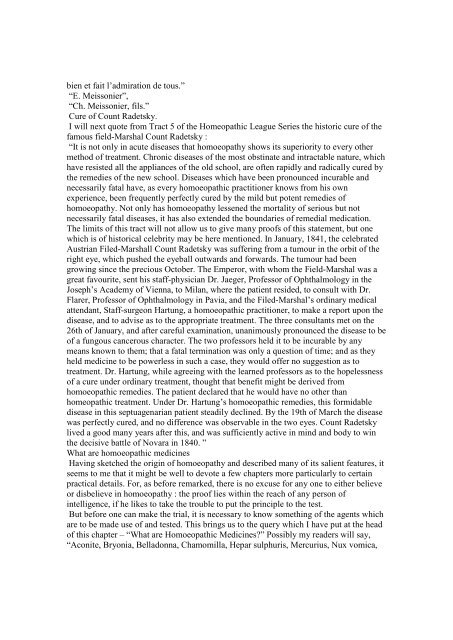CLARKE JH, Homoeopathy Explained - Classical Homeopathy Online
CLARKE JH, Homoeopathy Explained - Classical Homeopathy Online
CLARKE JH, Homoeopathy Explained - Classical Homeopathy Online
You also want an ePaper? Increase the reach of your titles
YUMPU automatically turns print PDFs into web optimized ePapers that Google loves.
ien et fait l’admiration de tous.”<br />
“E. Meissonier”,<br />
“Ch. Meissonier, fils.”<br />
Cure of Count Radetsky.<br />
I will next quote from Tract 5 of the Homeopathic League Series the historic cure of the<br />
famous field-Marshal Count Radetsky :<br />
“It is not only in acute diseases that homoeopathy shows its superiority to every other<br />
method of treatment. Chronic diseases of the most obstinate and intractable nature, which<br />
have resisted all the appliances of the old school, are often rapidly and radically cured by<br />
the remedies of the new school. Diseases which have been pronounced incurable and<br />
necessarily fatal have, as every homoeopathic practitioner knows from his own<br />
experience, been frequently perfectly cured by the mild but potent remedies of<br />
homoeopathy. Not only has homoeopathy lessened the mortality of serious but not<br />
necessarily fatal diseases, it has also extended the boundaries of remedial medication.<br />
The limits of this tract will not allow us to give many proofs of this statement, but one<br />
which is of historical celebrity may be here mentioned. In January, 1841, the celebrated<br />
Austrian Filed-Marshall Count Radetsky was suffering from a tumour in the orbit of the<br />
right eye, which pushed the eyeball outwards and forwards. The tumour had been<br />
growing since the precious October. The Emperor, with whom the Field-Marshal was a<br />
great favourite, sent his staff-physician Dr. Jaeger, Professor of Ophthalmology in the<br />
Joseph’s Academy of Vienna, to Milan, where the patient resided, to consult with Dr.<br />
Flarer, Professor of Ophthalmology in Pavia, and the Filed-Marshal’s ordinary medical<br />
attendant, Staff-surgeon Hartung, a homoeopathic practitioner, to make a report upon the<br />
disease, and to advise as to the appropriate treatment. The three consultants met on the<br />
26th of January, and after careful examination, unanimously pronounced the disease to be<br />
of a fungous cancerous character. The two professors held it to be incurable by any<br />
means known to them; that a fatal termination was only a question of time; and as they<br />
held medicine to be powerless in such a case, they would offer no suggestion as to<br />
treatment. Dr. Hartung, while agreeing with the learned professors as to the hopelessness<br />
of a cure under ordinary treatment, thought that benefit might be derived from<br />
homoeopathic remedies. The patient declared that he would have no other than<br />
homeopathic treatment. Under Dr. Hartung’s homoeopathic remedies, this formidable<br />
disease in this septuagenarian patient steadily declined. By the 19th of March the disease<br />
was perfectly cured, and no difference was observable in the two eyes. Count Radetsky<br />
lived a good many years after this, and was sufficiently active in mind and body to win<br />
the decisive battle of Novara in 1840. ”<br />
What are homoeopathic medicines<br />
Having sketched the origin of homoeopathy and described many of its salient features, it<br />
seems to me that it might be well to devote a few chapters more particularly to certain<br />
practical details. For, as before remarked, there is no excuse for any one to either believe<br />
or disbelieve in homoeopathy : the proof lies within the reach of any person of<br />
intelligence, if he likes to take the trouble to put the principle to the test.<br />
But before one can make the trial, it is necessary to know something of the agents which<br />
are to be made use of and tested. This brings us to the query which I have put at the head<br />
of this chapter – “What are Homoeopathic Medicines?” Possibly my readers will say,<br />
“Aconite, Bryonia, Belladonna, Chamomilla, Hepar sulphuris, Mercurius, Nux vomica,
















